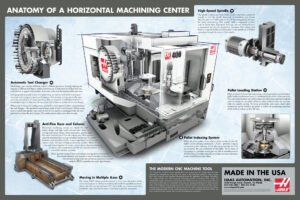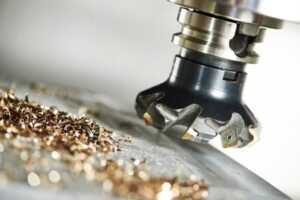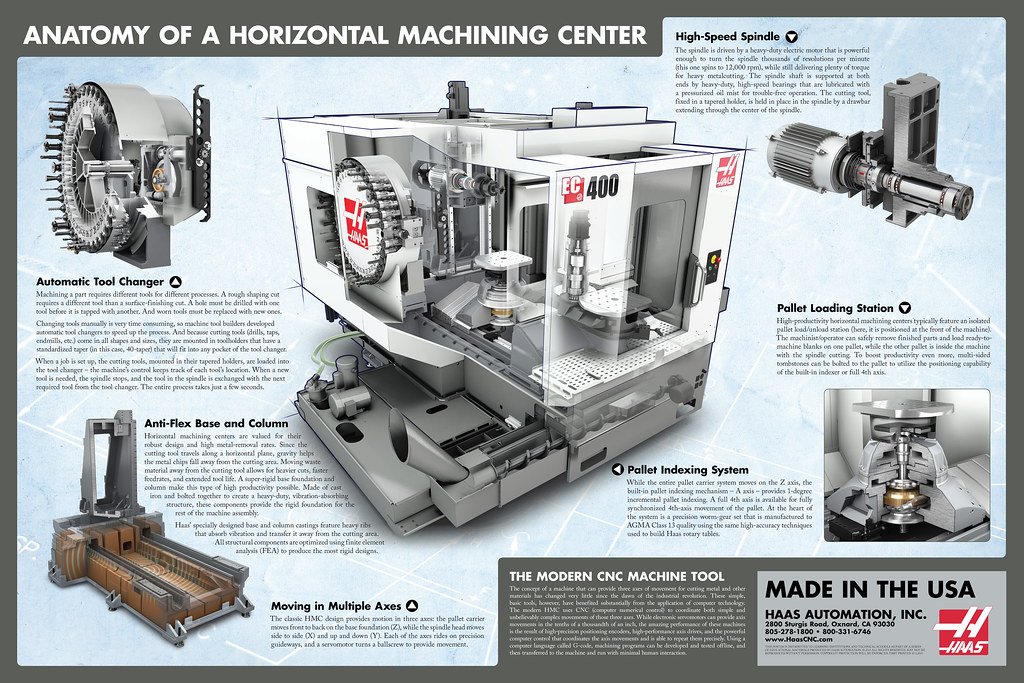A CNC milling machine, short for Computer Numerical Control milling machine, is a versatile piece of equipment used in manufacturing and prototyping processes. It operates under the control of a computer program that directs the movement of the machine’s cutting tools to remove material from a workpiece to create a desired shape or pattern.
CNC milling machines are capable of producing intricate and precise parts across a wide range of materials, including metals, plastics, and wood. They are widely used in industries such as aerospace, automotive, and electronics for their accuracy, efficiency, and ability to automate repetitive tasks. In this article, MaTec Vietnam will help you explore CNC Milling Machine Components in detail.
CNC Milling Machine Components
CNC milling machines are a prevalent manufacturing tool utilized across a multitude of industries, hence it’s unsurprising to find numerous brands of this equipment, with variations present from workshop to workshop.
Nevertheless, every CNC mill comprises fundamental components that enable its intended functionality. Below, I’ve compiled a list of the standard and most common components of CNC milling machines that you should be acquainted with.
CNC Controller
The CNC controller functions as the central processing unit of the machine, governing its movements and operations.
It interprets the CNC program or G-code provided by the input device, translating these commands into corresponding machine actions. Subsequently, the CNC controller directs the execution of these commands by transmitting appropriate signals to the stepper and servo motors, facilitating precise and efficient machining processes.

Column and Base
The column and base serve as the structural foundation of the CNC machine, supporting all other components while providing stability and damping vibrations generated during machining.
Typically crafted from cast iron, these components are often filled with epoxy granite to enhance their vibration resistance, thereby contributing to the production of higher quality machined parts.
The base bears the weight of the entire machine, while the column, a vertical structure connected to the base, travels along an axis. It houses the tool turret and accommodates the oil and coolant system.
Knee
The knee, a cast iron element affixed to the column via a dovetail, can be vertically adjusted through a positioning screw, facilitating vertical movement of the work table. Additionally, it offers supplementary support to the saddle and milling table.
CNC mills feature an automated system for knee adjustment based on the supplied G-code, although manual adjustment via a hand crank is also feasible.
Saddle
Positioned between the knee and the work table, the saddle, typically composed of cast iron, provides support to the work table and enables both vertical and horizontal adjustment of the workpiece.
Feed Mechanism
Housed within the knee, the feed mechanism constitutes an electromechanical system regulating vertical (up and down), longitudinal (left and right), and transverse (in and out) feeds.
Comprising electrical motors receiving signals from the controller, this mechanism effectuates desired movements in the workpiece to facilitate cutting operations.
Work Table
Primarily serving as the platform for machining operations, the work table, typically constructed from cast iron, facilitates workpiece fixation during machining.
Mounted atop the saddle, it features T-slots allowing for diverse fastening methods such as clamps or vises. Work tables are adjustable, with their movement governed by the power feed mechanism.
>>> Read more: What are the Differences between CNC Turning and CNC Milling?
Ram
Specific to vertical milling machines, the ram is an adjustable arm-like component positioned atop the column, responsible for holding the milling head.
Overhanging Arm
Distinctive to horizontal CNC milling machines, the overhanging arm, a cast iron beam mounted on the column, supports the milling head and its tool assembly.
Arbor Support
Exclusive to horizontal milling machines, the arbor support, crafted from cast iron, connects to the spindle via bearings, providing support to the cutting tool. Moreover, it plays a crucial role in dampening vibrations arising from machining operations.
Spindle
As a pivotal component of the CNC system, the spindle houses the milling tool via a taper. Linked to the main motor of the CNC machine, the spindle, guided by the CNC controller, rotates at specified speeds, driving the cutting tool. Additionally, it accommodates the milling chuck.
Tool Changer
CNC machines often employ automatic tool changers, particularly when a workpiece necessitates multiple milling operations. This component enables uninterrupted machining by swiftly exchanging cutting tools as required.
Various types of tool changers exist, differing in magazine arrangement and tool holding capacity, ranging from chain magazines capable of holding over 100 tools to turret head types accommodating a maximum of 8 tools.
Milling Tool
Central to cutting operations, the milling tool, affixed to the column, executes milling tasks according to the operator-supplied G-code. A variety of cutting tools exist, each tailored to specific milling operations and materials, ensuring optimal machining performance.
Control Panel
Functioning as the primary interface for operators, the control panel facilitates interaction with the CNC machine and enables control over its operations. Comprising input devices, display units, keyboards, and control switches, the control panel empowers operators to issue commands, select functions, and monitor operations effectively.

How Does a CNC Machine Operate?
Now that you’re acquainted with the standard components of a CNC mill, you might be curious about its operational mechanics.
So, how exactly does a CNC machine function? Let’s delve into the fundamental principles and operational dynamics of a CNC machine.
In CNC machining, operators employ a CAD model to craft a customized part. Here’s how it unfolds:
- The operator transforms the CAD model into a sequence of instructions known as G-code. This data is inputted into the Machine Control Unit (MCU) using an input device.
- The workpiece, typically raw material, is affixed onto the work table. It may be held in place by a vice or directly mounted on the machine bed. Precise positioning and alignment are crucial for crafting highly accurate parts.
- The MCU deciphers the G-code and transmits pertinent instructions to the driving system, which encompasses motors responsible for maneuvering the tool across various machine axes, such as the servo motor.
- The machine tool selectively removes material from the workpiece to shape the desired part. Initially, material is removed swiftly with lower precision to establish approximate geometry. Subsequently, several high-precision passes are executed to refine the part’s features.
- A feedback system monitors the position and velocity of the machine tool, relaying feedback signals to the MCU. In the event of discrepancies, the MCU issues corrective signals for necessary adjustments.
- Following machining operations, critical dimensions may need verification if tolerances are specified. Subsequently, the part is deemed ready for utilization or subjected to post-processing.
Typically, CNC milling machines traverse along three linear axes: X, Y, and Z. Advanced systems may also incorporate rotary axes. 5-axis CNC machines excel in crafting intricate geometries with ease.

Conclusion
Understanding the components of a CNC milling machine provides valuable insight into its functionality and capabilities. From the CNC controller serving as the brain of the machine to essential components like the column, knee, and spindle, each part plays a crucial role in the machining process.
Additionally, advancements such as automated tool changers and precision feed mechanisms contribute to the efficiency and versatility of CNC milling machines. If you are looking for a reliable partner for CNC milling services, MaTec Vietnam is the best choice for you. So, contact us now to receive the best quote.

